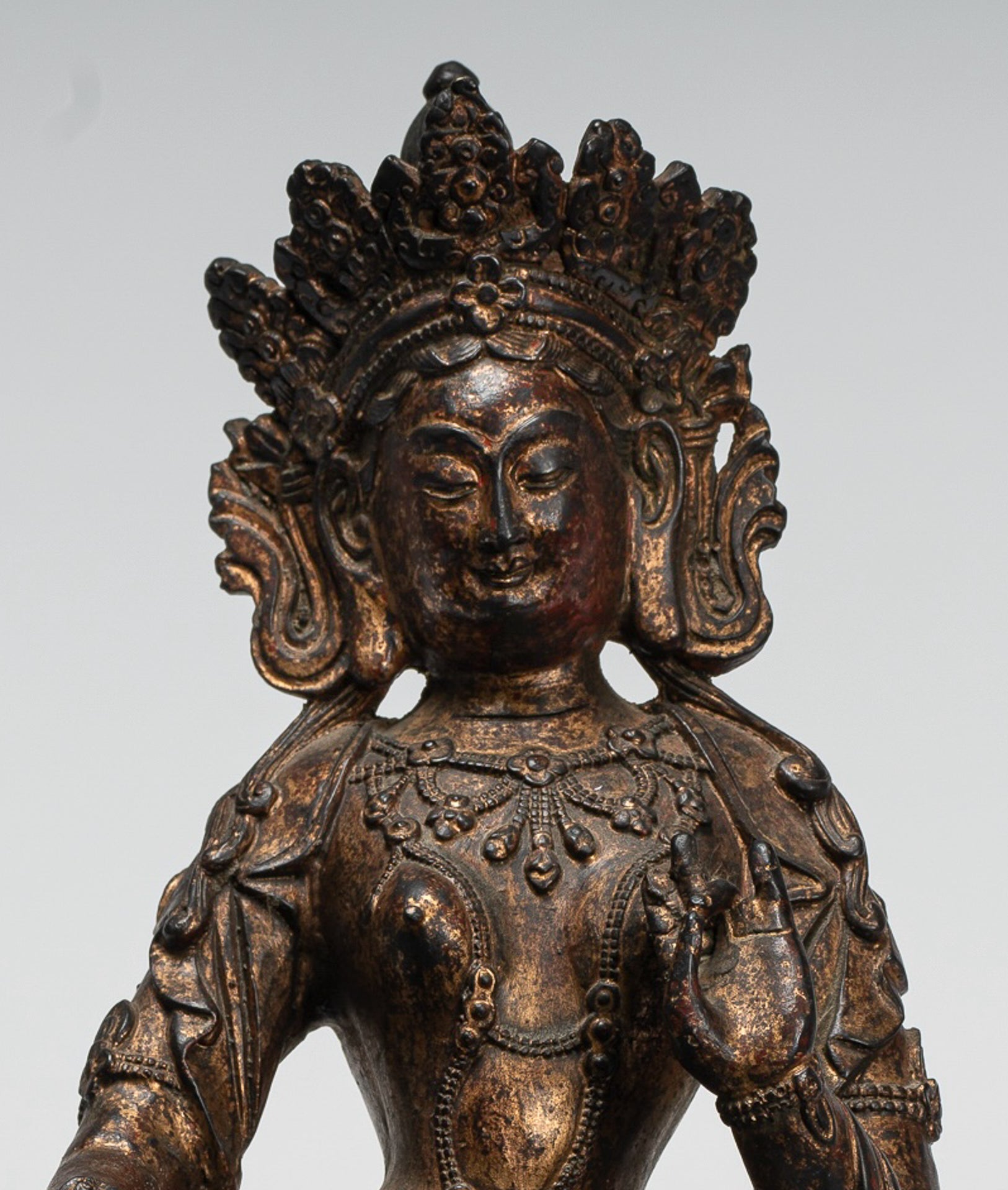-
Buddha Statue - Antique Tibet Style Seated Bronze Teaching Buddha - 28cm/11"
Measures (Height) 28cm/11"
A antique Tibet style seated Teaching Buddha.
This magnificent Buddha is is seated in the Dharmachakra or Teaching mudra and is remarkable for its realistic yet delicate delineation of the limbs and the robe which seems to cling to the body.
Upon his head he wears a decorative Tibetan style tiara in front of his Kirita-Makuta or tall conical crown. This symbolises control over Positive and Negative attitudes.
His robe is draped from both shoulders. A portion of the garment that covers the left wrist falls behind the figure. The lower hem of the robe comes all the way down so that the under-cloth or skirt is completely covered.
He holds his left hand raised in front of his chest in the Dharmachakra or Teaching mudra. In sanskrit dharmachakra means the 'Wheel of Dharma'. This mudra symbolises one of the most important moments in the life of Buddha, the occasion when he preached to his companions the first sermon after his Enlightenment in the Deer Park at Sarnath. It therefore denotes the setting into motion of the Wheel of the teaching of the Dharma.
In this mudra the thumb and index finger touch at their tips to form a circle. This circle represents the Wheel of Dharma, or in metaphysical terms, the union of method and wisdom. This symbolises generosity.
Buddha holds a vajra in his right hand. The Vajra is a legendary and ritualistic weapon, symbolizing the properties of a diamond (indestructibility) and a thunderbolt (irresistible force).
The vajra is a type of club with a ribbed spherical head. The ribs meet in a ball-shaped top. It is used symbolically by the dharmic traditions of Hinduism, Buddhism and Jainism, often to represent firmness of spirit and spiritual power.
The use of the vajra as a symbolic and ritual tool is mainly found in Tantric Buddhism.
Buddha is seated upon a double lotus flower pedestal. The lotus flower represents the attaining of enlightenment and the ultimate fulfilment that follows. This symbol is heavily used in Eastern religions, which is why it can appear as both a held item or a seat. Some say that as the lotus flower grows in dirty water but becomes something beautiful, it demonstrates how we must forget our attachments to the material world around us and focus on our inner spirituality in order to seek happiness.
A delightful and rare piece with wonderful aureate and sepia patina.
SATISFACTION GUARANTEE - We have been offering SE Asian Art for many years and are proud of the reputation we have developed for fair and honest listings. However, if for any reason, whatsoever, you are unhappy with your purchase please just let us know and we will provide a full refund. We want you to be 100% happy with your purchase.
-
The majority of orders will be shipped with DHL. This is a secure, express and fully tracked service.
Items less than 2Kg we typically ship using Royal Mail.
Once we receive your order we try to ship all orders the same or next working day.
Large and/or fragile pieces requiring palletising, specialist crating and/or extra packaging may take a little longer. Palletised shipments will be delivered curbside.
All orders over 35 GBP will be shipped free of charge.

-
We genuinely hope that all purchases delight.
However, if they do not, regardless of reason, we will refund all orders upon receipt of the unwanted item. Just notify us within 14 days of receiving your order that you wish to make a return and send the piece back to us with 30 days of delivery.
Thai Sukhothai Buddha images are often considered the purest expression of Thai Buddhist aesthetics, combining spiritual serenity with flowing, almost flame‑like elegance.
They emerged in the Sukhothai Kingdom (13th–15th centuries) and went on to define what many people today instinctively recognize as the “classic Thai Buddha.”






















































